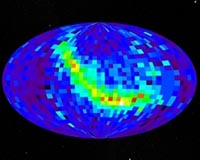|
|
|
IBEX Explores Galactic Frontier, Releases First-Ever All-Sky Map Washington DC (SPX) Oct 16, 2009  NASA's Interstellar Boundary Explorer, or IBEX, spacecraft has made it possible for scientists to construct the first comprehensive sky map of our solar system and its location in the Milky Way galaxy. The new view will change the way researchers view and study the interaction between our galaxy and sun. The sky map was produced with data that two detectors on the spacecraft collected ... read more
NASA's Interstellar Boundary Explorer, or IBEX, spacecraft has made it possible for scientists to construct the first comprehensive sky map of our solar system and its location in the Milky Way galaxy. The new view will change the way researchers view and study the interaction between our galaxy and sun. The sky map was produced with data that two detectors on the spacecraft collected ... read moreLunar Lander Floats On Electric-Blue Jets  Huntsville AL (SPX) Oct 16, 2009
Huntsville AL (SPX) Oct 16, 2009How do you fly on a world with no atmosphere? Wings won't work and neither do propellers. And don't even try that parachute! NASA engineer Brian Mulac has the answer. "All it takes is practice, practice, practice," he says. "And of course, thrusters." The space agency is perfecting the art using a prototype lunar lander at the Marshall Space Flight Center: "What we've got here is a 'flying ... more
|
Vietnam says parched Red River at record low
China to be world's third biggest wind power producer: media Cost-cutting NASA eyes three cheap space missions Honduras declares state of emergency amid drought Russia in secret plan to save Earth from asteroid: official Sarkozy scrambles to salvage carbon tax French carbon tax ruled illegal Brazil's Lula signs law cutting CO2 emissions 2009 a 'benign' year of natural disasters: German re-insurer Greenpeace Spain demands Denmark release its director
| |||||||||||||||
| Previous Issues | Oct 15 | Oct 14 | Oct 13 | Oct 12 | Oct 09 |
| . |
How The Moon Produces Its Own Water Paris, France (ESA) Oct 16, 2009
Paris, France (ESA) Oct 16, 2009The Moon is a big sponge that absorbs electrically charged particles given out by the Sun. These particles interact with the oxygen present in some dust grains on the lunar surface, producing water. This discovery, made by the ESA-ISRO instrument SARA onboard the Indian Chandrayaan-1 lunar orbiter, confirms how water is likely being created on the lunar surface. It also gives scientists an ... more The Milky Way's Tiny But Tough Galactic Neighbour  Paris, France (SPX) Oct 16, 2009
Paris, France (SPX) Oct 16, 2009ESO has announced the release of a stunning new image of one of our nearest galactic neighbours, Barnard's Galaxy, also known as NGC 6822. The galaxy contains regions of rich star formation and curious nebulae, such as the bubble clearly visible in the upper left of this remarkable vista. Astronomers classify NGC 6822 as an irregular dwarf galaxy because of its odd shape and relatively ... more NASA probe helps to map solar system  Washington (AFP) Oct 15, 2009
Washington (AFP) Oct 15, 2009A NASA probe exploring the outer edges of the solar system has helped scientists create the first map of this little-understood region of space 10 billion miles (16 billion kilometers) from Earth. Data from the US space agency's Interstellar Boundary Explorer (IBEX) spacecraft is helping researchers explore the boundary between our Sun and the rest of the galaxy by collecting high-speed atom ... more |
. |
| . |
Hubble Observes LCROSS Impact Event Pasadena CA (SPX) Oct 12, 2009
Pasadena CA (SPX) Oct 12, 2009NASA's Hubble Space Telescope has made a series of observations immediately preceding and following the Lunar Crater Observation and Sensing Satellite (LCROSS) Centaur rocket stage and shepherding spacecraft impacts at the lunar south pole, on October 9 at 7:31 and 7:35 a.m. EDT. Hubble's Wide Field Camera 3 (WFC3) and Space Telescope Imaging Spectrograph (STIS) were pointed just off the ... more NASA blasts moon with rocket in search for water  Washington (AFP) Oct 9, 2009
Washington (AFP) Oct 9, 2009The United States successfully blasted a rocket into the moon on Friday, slamming it into a crater near the lunar south pole in a bid to discover water, US space agency NASA said. No light flash was visible in the thermal images broadcast on NASA television, as the 2.3-tonne rocket impacted the Cabeus crater at 1131 GMT. A second shepherding spacecraft flew through the debris plume, coll ... more Europa's Ocean Contains Enough Oxygen To Support Life  Tucson AZ (SPX) Oct 09, 2009
Tucson AZ (SPX) Oct 09, 2009The global ocean on Jupiter's moon Europa contains about twice the liquid water of all the Earth's oceans combined. New research suggests that there may be plenty of oxygen available in that ocean to support life, a hundred times more oxygen than previously estimated. The chances for life there have been uncertain, because Europa's ocean lies beneath several miles of ice, which separates ... more |
. |
| Previous Issues | Oct 15 | Oct 14 | Oct 13 | Oct 12 | Oct 09 |
| The contents herein, unless otherwise known to be public domain, are Copyright 1995-2009 - SpaceDaily. AFP and UPI Wire Stories are copyright Agence France-Presse and United Press International. ESA Portal Reports are copyright European Space Agency. All NASA sourced material is public domain. Additional copyrights may apply in whole or part to other bona fide parties. Advertising does not imply endorsement, agreement or approval of any opinions, statements or information provided by SpaceDaily on any web page published or hosted by SpaceDaily. Privacy statement |